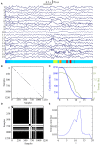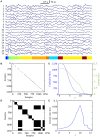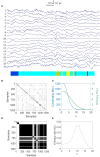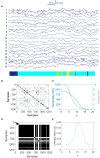Transcranial Direct Current Stimulation (tDCS) Can Modulate EEG Complexity of Children With Autism Spectrum Disorder
- PMID: 29713261
- PMCID: PMC5911939
- DOI: 10.3389/fnins.2018.00201
Transcranial Direct Current Stimulation (tDCS) Can Modulate EEG Complexity of Children With Autism Spectrum Disorder
Abstract
Autism spectrum disorder (ASD) is a heterogeneous neurodevelopmental disorder which affects the developmental trajectory in several behavioral domains, including impairments of social communication, cognitive and language abilities. Transcranial direct current stimulation (tDCS) is a non-invasive brain stimulation technique, and it was used for modulating the brain disorders. In this paper, we enrolled 13 ASD children (11 males and 2 females; mean ± SD age: 6.5 ± 1.7 years) to participate in our trial. Each patient received 10 treatments over the dorsolateral prefrontal cortex (DLPFC) once every 2 days. Also, we enrolled 13 ASD children (11 males and 2 females; mean ± SD age: 6.3 ± 1.7 years) waiting to receive therapy as controls. A maximum entropy ratio (MER) method was adapted to measure the change of complexity of EEG series. It was found that the MER value significantly increased after tDCS. This study suggests that tDCS may be a helpful tool for the rehabilitation of children with ASD.
Keywords: autism spectrum disorder (ASD); complexity; electroencephalography (EEG); maximum entropy ratio (MER); transcranial direct current stimulation (tDCS).
Figures





Similar articles
-
Assessing the impact of Transcranial Direct Current Stimulation (tDCS) over the dorsolateral prefrontal cortex on social communication in children and adolescents with Autism Spectrum Disorder (ASD).Res Dev Disabil. 2025 Jun;161:104958. doi: 10.1016/j.ridd.2025.104958. Epub 2025 Mar 25. Res Dev Disabil. 2025. PMID: 40138870
-
Modulation of Resting-State Brain Complexity After Bilateral Cerebellar Anodal Transcranial Direct Current Stimulation in Children with Autism Spectrum Disorders: a Randomized Controlled Trial Study.Cerebellum. 2023 Dec;22(6):1109-1117. doi: 10.1007/s12311-022-01481-6. Epub 2022 Sep 26. Cerebellum. 2023. PMID: 36156195 Clinical Trial.
-
Effect of Transcranial Direct Current Stimulation on the Mismatch Negativity Features of Deviated Stimuli in Children With Autism Spectrum Disorder.Front Neurosci. 2022 Feb 9;16:721987. doi: 10.3389/fnins.2022.721987. eCollection 2022. Front Neurosci. 2022. PMID: 35221894 Free PMC article.
-
Brain stimulation by tDCS as treatment option in Autism Spectrum Disorder-A systematic literature review.Prog Brain Res. 2021;264:233-257. doi: 10.1016/bs.pbr.2021.03.002. Epub 2021 Apr 16. Prog Brain Res. 2021. PMID: 34167658
-
Transcranial direct current stimulation in Autism Spectrum Disorder: A systematic review and meta-analysis.Eur Neuropsychopharmacol. 2021 Jul;48:89-109. doi: 10.1016/j.euroneuro.2021.02.017. Epub 2021 Mar 24. Eur Neuropsychopharmacol. 2021. PMID: 33773886
Cited by
-
Systemic Review on Transcranial Electrical Stimulation Parameters and EEG/fNIRS Features for Brain Diseases.Front Neurosci. 2021 Mar 26;15:629323. doi: 10.3389/fnins.2021.629323. eCollection 2021. Front Neurosci. 2021. PMID: 33841079 Free PMC article. Review.
-
Transcranial direct current stimulation modulates brain functional connectivity in autism.Neuroimage Clin. 2020;28:102500. doi: 10.1016/j.nicl.2020.102500. Epub 2020 Nov 19. Neuroimage Clin. 2020. PMID: 33395990 Free PMC article.
-
A systematic review of randomized controlled trials on efficacy and safety of transcranial direct current stimulation in major neurodevelopmental disorders: ADHD, autism, and dyslexia.Brain Behav. 2022 Sep;12(9):e2724. doi: 10.1002/brb3.2724. Epub 2022 Aug 8. Brain Behav. 2022. PMID: 35938945 Free PMC article.
-
Recent advancements in noninvasive brain modulation for individuals with autism spectrum disorder.Neural Regen Res. 2023 Jun;18(6):1191-1195. doi: 10.4103/1673-5374.360163. Neural Regen Res. 2023. PMID: 36453393 Free PMC article. Review.
-
The role of structural and functional parameters in designing pathology-specific tDCS protocols for primary progressive aphasia.Alzheimers Res Ther. 2025 Jul 14;17(1):156. doi: 10.1186/s13195-025-01737-3. Alzheimers Res Ther. 2025. PMID: 40660278 Free PMC article.
References
-
- Amatachaya A., Jensen M. P., Patjanasoontorn N., Auvichayapat N., Suphakunpinyo C., Janjarasjitt S., et al. . (2015). The short-term effects of transcranial direct current stimulation on electroencephalography in children with autism: a randomized crossover controlled trial. Behav. Neurol. 2015:928631. 10.1155/2015/928631 - DOI - PMC - PubMed
LinkOut - more resources
Full Text Sources
Other Literature Sources
Miscellaneous

